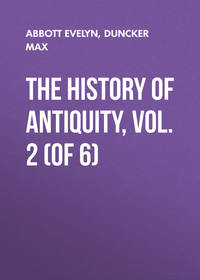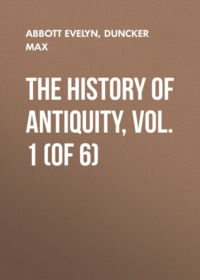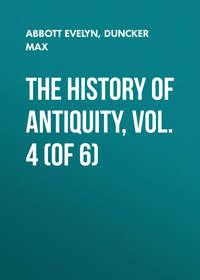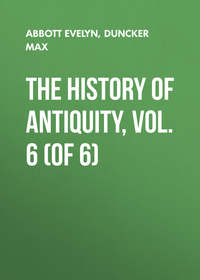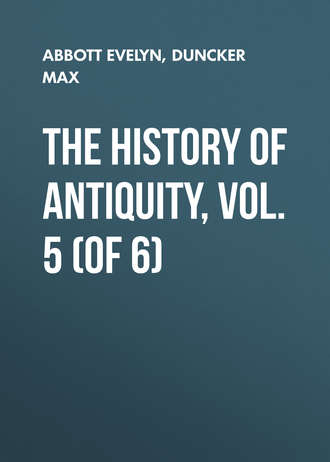 полная версия
полная версияThe History of Antiquity, Vol. 5 (of 6)
Another episode tells us of the contests which the Medes had to sustain under the dominion of Astibaras-Artaeus, i. e. of Cyaxares, against the Parthians and the Sacæ. The Parthians, whose chief was Marmares, revolted from the Medes, but handed over their land and city to the king of the Sacæ, Cydraeus, that he might protect them against the Medes; and the sister of Cydraeus, Zarinaea (Zaranya, i. e. the golden), who was distinguished for her beauty and wisdom, her boldness and bravery (for the women of the Sacæ took the field with the men), became the wife of Marmares. As the Medians intended to reduce the Parthians again to subjection, a war broke out between them and the Parthians and Sacæ, which lasted for several years, and led to battles in which many fell on one side and the other. In one of these battles Zarinaea was wounded. Stryangaeus, the Mede, to whom Cyaxares had given his daughter Rhoetæa to wife, pursued, overtook, and threw her from her horse. But the sight of her beauty and youth, and her entreaties, moved him; he allowed her to escape. Not long afterwards Stryangaeus with other Medes was taken captive by the Parthians. Marmares wished to put him to death, and though Zarinaea entreated for his life, insisted on his execution. Then Zarinaea loosed the bonds of the captive Medes, caused Marmares to be put to death by them, and allowed Stryangaeus to escape. When, after the death of her brother Cydraeus, she ascended the throne of the Sacæ, she sent messengers to the king of the Medes to conclude peace and friendship. The Parthians were to return under the sovereignty of the Medes, the Sacæ and Medes were to keep what previously belonged to them, and to be friends and allies for ever. This was done. Stryangaeus, the real author of this treaty, ever since the battle in which he had first seen Zarinaea, had been possessed with violent love for her, and went to Roxanace (i. e. the brilliant),485 where was the royal citadel of the Sacæ, in order to see the beloved princess once more. Zarinaea, who returned his affection, came to see him full of joy, received him and his attendants in the most splendid manner, kissed him in the sight of all, and ascended his chariot, and thus, while conversing with each other they arrived in the palace. Here Stryangaeus sighed in the chambers assigned to him, and could not resist the violence of his passion. At length he took counsel with the most faithful of his eunuchs, who encouraged him to discover his passion to Zarinaea. Easily persuaded, Stryangaeus hastened to the queen, and after much delay and many sighs, sometimes blushing and again turning pale, he ventured to declare that he was consumed with love for her. Zarinaea answered quietly and gently that it would be shameful and fatal for her to surrender herself to him, and far more shameful and dangerous for Stryangaeus, as his wife was the daughter of the king of the Medes, and, as she heard, more beautiful than herself and many other women. He must be brave, not only against his enemies, but against himself, and not bring about a long calamity for the sake of a brief enjoyment. No other wish of his but this should remain unsatisfied. Stryangaeus was silent for a long time, then embraced and kissed the queen, and departed. He was far more dejected than before, and determined to take his life. "Thou hast been saved by me," he wrote to Zarinaea, "but through thee I am destroyed. If in this thou hast done justly, then may all good things be thine, and mayest thou be happy; if thou hast done evil, may a passion like mine overtake thee." When he had bound the eunuch by an oath to give this letter to Zarinaea immediately after his death, he lay back on his cushions and demanded his sword. As the eunuch refused to give it, he ended his days by starvation. Zarinaea ruled over the Sacæ with wisdom and power. She conquered the neighbouring nations who sought to subjugate her people, caused a great part of the land to be cultivated, and built a considerable number of cities, and brought the Sacæ into greater prosperity. In gratitude for the benefits received from her, and in remembrance of her virtues, the Sacæ erected on her grave a three-sided pyramid, three stades in length on each side, and ending in a point a stadum in height, on which was placed a colossal golden statue of the queen. Worship was also offered to her as to a hero, so that she received greater honours than any of her predecessors.486
We have already acquainted ourselves with the land of the Parthians (p. 10). The Sacæ were neighbours of the Hyrcanians, the Parthians, and the Bactrians in the steppes of the Oxus. Herodotus tells us that the Sacæ were a nation of the tribe of the Scyths, and that their proper name was Amyrgians; the Persians called all the Scythians Sacæ. The inscriptions of Darius speak of Çaka Humavarka; in the second version the name is Omuvargap, and in the Babylonian-Assyrian version Umurga. According to the account of Herodotus the Sacæ wore trousers, and upright, pointed caps, and carried bows of a peculiar character, battle-axes and daggers. They fought as mounted bowmen. On the monument of Darius at Behistun Çakuka,487 the leader of the Sacæ, wears a tall pointed cap. In the army of Xerxes the Sacæ were ranged with the Bactrians. What our episode tells us of the royal citadel and the cities built by Zarinæa does not harmonise with the nature of the steppe-country of the Sacæ, and the statement of the Greeks, that the Sacæ lived in variegated tents, and that their wealth consisted in flocks of sheep, but it does agree with the fact that the women went to battle on horseback with the men. The companions of Alexander describe the Sacæ as strong, warlike, well-grown men, with flowing hair; the Macedonians only came up to their shoulders. Later accounts speak of heavy-armed horse among them; both horse and rider were covered with armour, and the weapons of attack were long lances.488 From the narratives given in the episodes we may retain the fact that although the Persians followed the lead of the Medes from the time of Phraortes, Cyaxares, even after the fall of Nineveh, did not succeed in subjugating the remaining nations of Iran without severe struggles. There is no reason to doubt that the Cadusians made an obstinate resistance, and maintained their independence: The Parthians were able to combine with the Sacæ in order to preserve their freedom, and did not become subject to Cyaxares without severe contests. That the Sagartians on the edge of the great desert (p. 6) were subject to Cyaxares, is clear from the inscription of Darius at Behistun. If the Medes had to fight with the Sacæ, who were settled on the Oxus, Bactria must have been reduced to form a part of their kingdom. Beside the Hyrcanians, Parthians, and "other nations," the Bactrians and Sacæ are specially mentioned as subjects of the Median kings,489 and Arrian assures us that the Açvakas, whom we found north of the Cabul on the right bank of the Indus (IV. 393), were subjects of the Medes.490
Herodotus tells us that Cyaxares was the first to separate the lance-bearers, archers, and horsemen, and combine them into divisions; that is, he introduced a better and more manageable arrangement of the army. To the same prince, no doubt, is due the completion of the fortifications of Ecbatana, which we found had been strengthened by his predecessor Phraortes. When the fortifications were first begun, the place was merely intended as a point of defence against Assyria; but as soon as it became destined to aid in the maintenance of independence, it was necessary that it should be capable of offering refuge and support to the Median army, if hard pressed. The mountains of the Zagrus form the boundary wall, and at the same time the line of division between the Medes and Assyrians. As Polybius told us (p. 268), it was an ascent of twelve miles —i. e. four leagues – to the top of the pass. If the Medes failed to hold these passes, and were then defeated in their own table-land, the mountains of the Orontes formed a new point of protection to their retreat. The Orontes (Old Persian, Urvanda; now Elvend) is a steep range of mountains, traversing Media from north-west to south-east; the heights of the passes are given by travellers at 7000 or 10,000 feet; Ctesias puts the ascent at twenty-five stades;491 recent explorers fix the time at four hours. On the eastern spur of this mountain wall, in a fertile plain, six leagues long and four leagues broad, lay Ecbatana, Old Persian Hangmatana, i. e. place of assembly, the Achmeta of the Hebrews. If the Orontes could not be held, the fortifications of Ecbatana formed a last point of protection for the Median army. From the Assyrians there was nothing more to be feared after the fall of Nineveh, but Cyaxares had no doubt felt, in the inundation of Media by the nomadic tribes of the Sacæ, and then in the final battles against Asshur, what a support was given by a strong metropolis; what good service the walls of Nineveh had rendered to the enemy, even in his decline. He saw what measures were being taken by Nebuchadnezzar, his step-son, to make his metropolis secure, and determined that the kingdom, which he had so rapidly and brilliantly erected and developed, should not be without the nucleus of an impregnable fortress and royal citadel. The booty in silver and gold, which the Medes gained in Nineveh, and of which we hear not in the Median poems only, but also from the Hebrew prophets who lived at the time of the fall of the city, provided no doubt ample means both for the erection of the strongest works, and for the adornment of these as well as the citadel.
Ctesias tells us that Semiramis built a splendid palace at Ecbatana, a city lying in a plain, and as there were no springs near, she cut through the roots of the range of mountains, twelve stades distant from the city (the Orontes), on the farther side of which was a lake flowing into a river, in order to convey the water of the river into the city. For this object a tunnel was cut through the mountain, fifteen feet in breadth and forty feet in depth, and through it the river was carried into Ecbatana.492 If Ctesias ascribes the palace of Ecbatana and the tunnel, like other monuments of Media, to Semiramis, we have already seen that the queen is no more than a poetical fiction; nor could any of the sovereigns who ruled over Assyria entertain the project of building citadels and conduits for the Median kings. These could only be the work of Median princes, who resided in Ecbatana; and as Phraortes could hardly have had the means and the time for such important structures, we must ascribe both the completion and adornment of the royal citadel, as well as the tunnel, to Cyaxares, unless we are to reject the latter as a pure invention, for which there seems to me no sufficient proof.
"When the palace had been built at Ecbatana, it was surrounded with large and strong walls," Herodotus tells us, "of which one encircled another, in such a manner that the inner overtopped the outer by the height of the turret. The situation, which was on a hill, contributed to this result, and the natural elevation was artificially increased. In all there were seven circles; the innermost contained the king's dwelling and treasure-house; the outermost wall was of about the extent of the wall of Athens. The towers of the first circle were white, of the second black, of the third red-purple, of the fourth blue-purple, of the fifth red; the towers of the sixth are covered with silver; and those of the seventh, which surrounds the buildings of the palace, with gold. The city was built round the outermost wall."493 Polybius describes the situation of Ecbatana and the palace as they were under the Achæmenids, who were wont to pass some of the hot summer months in the cool and fresh air of Ecbatana. "Ecbatana lies in the northern regions of Media, and commands the parts of Asia which look towards the Maeotis and the Euxine. The city was in old days the royal abode of the Median kings, and it appears to have far surpassed all other cities in wealth and in the splendour of its buildings. It is built under the spurs of the Orontes. Though without walls, it possesses a citadel built by the hand of man, of surprising strength. Below the citadel is the palace, which it is as difficult to speak of in detail as to pass over in silence. Ecbatana is an excellent theme for those who love to tell of marvellous things with adornment and exaggeration; but those who enter with caution on anything which goes beyond the ordinary intelligence find themselves in difficulties. The circuit of the palace is about seven stades, and the rich ornamentation of the various parts proves how flourishing was the condition of those who founded it. Though the entire wood-work consists of cedar and cypress, this is never allowed to appear; on the contrary, the beams of the roof and the panelling, the pillars in the chambers and halls, are covered with gold or silver plates, and the roof consists wholly of silver tiles. Most of these were carried off at the time of the expedition of Alexander, and the remainder in the reign of Antigonus and Seleucus-Nicanor. Nevertheless the temple of Aine (i. e. of Anahita) at the time when Antiochus Theos (261-245 B.C.) came to Ecbatana, had gilded pillars round it; and some of the gold plates in the side-walls were still remaining, and the greater part of the silver plates, while the silver tiles of the roof were still there in considerable quantities."494 At the time of Alexander, Diodorus allows the city of Ecbatana a circuit of 250 stades, i. e. of more than 30 miles.495 Isidore of Charax mentions the treasure-house at Ecbatana, the metropolis of Media and the shrine of Anaitis, in which sacrifice was constantly offered.496
It is not clear from these descriptions whether the fortifications at that time included the whole city or not. Herodotus only speaks of the fortifications of the citadel, and represents the city as built at the foot of its walls. Yet we may assume that Phraortes and Cyaxares followed the pattern of the chief cities of Assyria and Babylonia in placing a strong wall round their city. A late and very uncertain authority, the book of Judith, states that the walls of Ecbatana consisted of splendid masonry, and reached a height of seventy cubits (about 110 feet); the towers of these walls were a hundred cubits in height, and there were gates in them.497 When the Medes lost their empire and became subject to the Achæmenids, it was to their interest that the metropolis of the Medes should not be fortified, but that the citadel should be in the hands of a Persian garrison. Cyrus himself, therefore, after the conquest of Astyages, or Darius, after suppressing the rebellion of the Medes, may have thrown down the walls which surrounded Ecbatana. The silence of Herodotus respecting them would then be explained by the fact that they were no longer in existence in his time. The circuit of the external wall Herodotus compares with the circuit of the city of Athens, which, exclusive of the harbour cities but including the space between the Phaleric and the long walls, reached 60 stades, or 7-1/2 miles.498 If we chose to assume that Herodotus included the Phaleric and long walls in the circuit, the total extent would be 22-1/2 miles, an incredible length for the wall of a citadel. Of the outer walls of the royal citadels at Babylon, Diodorus puts those on the one bank of the Euphrates at 30 stades, and those on the other at 60, and of the two inner walls of the latter the first was 40 stades in length and the second 20.499 The circuit of 22-1/2 miles may, therefore, refer only to the whole extent of the citadel and city of Ecbatana, and it would then come near the statement of Diodorus, who puts the circuit of Ecbatana at 250 stades.
The royal citadel of the Achæmenids at Persepolis was surrounded, according to Diodorus, with a triple wall; the first wall was 16, the second 32, the third 60 cubits in height. These walls were decorated with great expense, and adorned with towers. The citadel of Ecbatana is said to have had seven walls, and, however strange this may appear, religious no less than military motives might have led to that number. We know the importance ascribed in the Avesta to the number seven – the seven supreme deities, and the seven girdles of the earth. On the other hand, if we leave out of sight the hill on which the citadel was built, the elevated plateau of Ecbatana did not present the natural difficulties such as rivers and heights, which strengthened the fortification of the Assyrian metropolis and the walls of Babylon; hence it was more important to meet this deficiency by the number of towers and walls. The successive walls would have been of little service had not each inner one been higher than the outer, and they would have been the reverse of serviceable, had not the distance between them been so great that the arrows and missiles of the enemy, when they had gained the outer walls, failed to reach from it to the next, so that the assault of the next wall had to be begun afresh after the capture of the adjacent outer wall, without any cover. If we might assume that the words of Polybius: "The palaces, of which the extent reaches to about seven stades, lie below the citadel," are to be interpreted as meaning that these buildings lay under the protection of the walls of the citadel, i. e. behind them – and it is scarcely conceivable that the Achæmenids should have chosen an unprotected palace in Media for a constant residence, and deposited there large treasures, and the archives of the kingdom – the circuit of the buildings of the palace and that of the external wall of 60 stadia would give a space between the walls of each of about 2000 feet; a distance not much in excess of that absolutely required. Hence the circuit of 60 stadia from the outer wall does not appear too large.
More astonishing still is the account given by Herodotus of the ornamentation of the turrets of these walls – the colours of the turrets of the first five, the silver and gold of the two last. The attempt has been made to explain these statements as a legendary echo of the fame of the splendour of Ecbatana in the time of Cyaxares and his successor Astyages. But Polybius tells us very distinctly that the roof of the palace and that of the temple of Anahita consisted of silver tiles at the time of the Achæmenids, that the beams and panels of the roofs as well as the pillars were entirely covered with gold and silver plates, and that these decorations remained in the temple of Anahita at the time of Antiochus Theos. This ornamentation might be extended to the turrets of the inner walls. Considering the amount of the spoil of Nineveh, it cannot be regarded as an impossibility that the ramparts of the interior walls, the length of which, according to the statement of Polybius, did not reach more than 4200 feet, were covered with plates of gold, and of the next with plates of silver, when the roof of the palace could consist of silver tiles. That the overthrow of the Assyrian kingdom and the spoil of the cities brought considerable possessions to the Median nation may be concluded from the remark of Herodotus that the Persians had adopted better clothing and more luxurious habits from the Medes. The kings would without doubt receive the richest part of the spoil. The decoration of the turrets was possibly rude, but it exhibited in a striking manner the splendour and exaltation of the kingdom, which was thus encased in gold and silver, while the sovereign dwelt in gold and silver chambers. Such a parade of royal magnificence is not out of harmony with the character of the ancient East. To those who were not allowed to enter the wide and high gates of the palace, these turrets showed far and wide, through city and country, the splendour of the citadel. The colours of the five outer walls would be given by glazed tiles, such as those found in the ruins of Nineveh and Chalah, of Babylon and Mugheir. We may assume with certainty that Cyaxares desired to give to his palace and citadel a splendour no less than that displayed by the palaces of Nineveh, or the royal citadel of Nebuchadnezzar in Babylon, or the golden citadel in Sardis. Religious conceptions may also have determined the colours of the decoration as well as the number of the walls. As Auramazda sat in pure light, on a golden throne on the golden Hukairya, so was the ruler on earth to dwell in his palace of Ecbatana in golden chambers surrounded by golden walls. The Avesta exhibits Mithra with a golden helmet and silver coat of mail, the wheels of his chariots are of gold, his horses are greys,500 shod on the fore hoofs with gold, and on the hinder hoofs with silver; in like manner the upper turrets of the citadel must shine with silver and the highest with gold. We have seen that the metals, owing to the brilliance inherent in them, belonged in the ideas of the Iranians to the good spirits. And as the splendour of gold and silver belonged to the highest gods, so must the colours of the other turrets have been assigned to the good spirits, to whose protection each separate wall was entrusted.501
The account which Polybius gives of the structure of the palace, the cedar and cypress wood of which the door-posts, pillars, roofs, and panels in the walls were made, shows that wood was employed in building in Media, which agrees with the habits of mountaineers. In Teheran and Ispahan buildings of wood of this kind are still in use, and no doubt the mountain forests of northern Media provided better materials in ancient times than now. The noblest trunks and best kinds of wood were sought out for the royal house. The kings of Asshur, and Nebuchadnezzar tell us in their inscriptions that they have caused trees to be cut down on this or that mountain for their buildings. The wooden palace, which Deioces, and perhaps Phraortes, first erected, must have been extended by Cyaxares, and may have been furnished by him or his successor with the brilliant ornamentation. The inner walls of the palace of the Achæmenids at Persepolis, if we may draw this conclusion from the metal supports which are found in the remains of the stone walls, were decorated in a similar manner. When the palace of the Median kings at Ecbatana had become the summer residence and treasure-house of the Persian monarchs, it would, no doubt, be enriched and adorned yet more. The temple of Anahita, connected with the palace, which Polybius has described above, is the work of Artaxerxes II. Alexander caused the spoil he had taken in Babylon, Susa, Persepolis, and Pasargadæ, to be brought to Ecbatana, where he is said to have collected 180,000 talents in gold and silver.502 At a later time, the Arsacids are said to have resided at Ecbatana during the summer like the Achæmenids.503 At the present day, Hamadan, which is built high up on a slope of Elvend, marks the site of the ancient Ecbatana. It contains about 40,000 inhabitants; the ruins of the ancient city have not yet been satisfactorily explored. The slender pillars with lotus-like capitals, discovered here, are like the pillars of Persepolis, and therefore might be the work of the Achæmenids; what has been discovered in engraved stones and coins comes from the time of the Arsacids and Sassanids. Some cylinders covered with cuneiform inscriptions have not yet been examined.
Cyaxares had rescued Media from the most extreme peril. The consequences of the defeat, in which his father, with the greatest part of his army, fell before the Assyrians, had been averted. Though subsequently overpowered by the Scythians, he yet became once more sovereign in his own country. This rise of Media, and the weakening of the Assyrian kingdom by the inundation of the Scythians, he used in order to subjugate Armenia and Cappadocia. And though he was not able to achieve anything decisive against the Lydians, he attained a greater success; in combination with Babylonia he avenged on the Assyrians the supremacy they had exercised over Media; he overthrew the remnant of that kingdom, whose tough vigour showed itself even at the final hour in an obstinate resistance. It was a great achievement and at the same time an important extension of the Median dominions, not merely by the whole extent of the Assyrian country on the left bank of the Tigris, which fell to Media, but also by the closer connection which Cyaxares thus obtained with Armenia and Cappadocia, the subject lands to the west. Then followed the spread of the Median power over the kindred nations in the north and east of Iran. The Persians were already subjected to Phraortes, and Cyaxares brought under his sovereignty the Sagartians, Hyrcanians, Parthians, and Bactrians; he made the Sacæ dependant on him, and in the east perhaps extended his power as far as the Indus. From his proud citadel at Ecbatana he ruled from the Halys to the Oxus. It was a powerful empire. Herodotus depicts the reign of Cyaxares when he says: "He was far more powerful than his predecessors." With the Medes he passes as the founder of their sovereignty; and his reign must have been held in grateful remembrance, not by the Medes only, but also by the subject nations. Those who afterwards attempted to bring the Medes and Sagartians under arms against the dominion of the Persians, called themselves the descendants of Cyaxares – and one even laid aside his own name, Phraortes, to do so.


